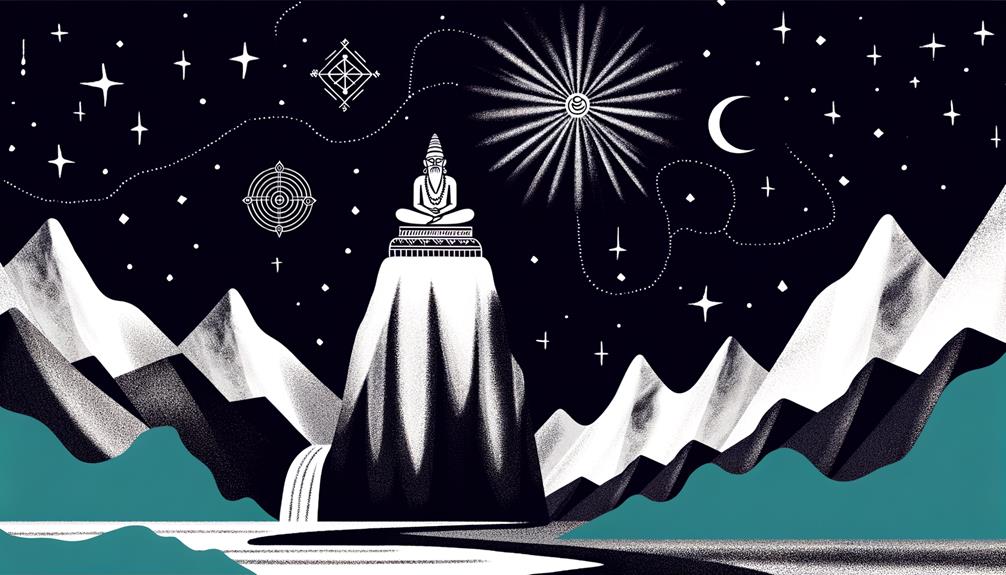Meaning of the Name Shiva
The name Shiva originates from the ancient Sanskrit term 'śiva', which signifies 'auspicious' or 'benevolent'. This etymology reflects attributes of purity and graciousness.
Within Hindu mythology, Shiva embodies both destruction and regeneration, forming a pivotal part of the Trimurti alongside Brahma and Vishnu. Iconographically, Shiva is associated with symbols like the trident, third eye, and crescent moon, each representing different cosmic principles.
The name encapsulates profound spiritual and philosophical dimensions within Hinduism, manifesting in various worship practices and cultural depictions. Understanding these intricate aspects of Shiva reveals deeper layers of his significance.

Key Takeaways
- The name Shiva originates from ancient Sanskrit language.
- Derived from the root word 'śiva', it means 'auspicious' or 'benevolent'.
- Conveys notions of purity and graciousness.
- Employed in various Vedic texts.
- Represents auspiciousness and benevolence in Hindu mythology.
Etymology of Shiva
The etymology of 'Shiva' traces its origins to the ancient Sanskrit language, where it is derived from the root word 'śiva,' meaning 'auspicious' or 'benevolent.'
In classical Sanskrit, 'śiva' also conveys notions of purity and graciousness. The term's semantic field extends beyond mere auspiciousness, encapsulating a complex interplay of positive attributes.
Historically, the name 'Shiva' has been employed in various Vedic texts to signify a favorable and propitious presence.
Linguistic studies highlight that 'śiva' is a cognate to the Prakrit term 'siva,' which holds similar connotations.
This etymological journey underscores the profundity and reverence associated with the name, reflecting its deep-rooted significance in the ancient linguistic and cultural milieu of the Indian subcontinent.
Shiva in Hindu Mythology
In Hindu mythology, Shiva is revered as one of the principal deities, embodying the dual aspects of destruction and regeneration. As part of the Trimurti, alongside Brahma and Vishnu, Shiva plays a pivotal role in the cosmic functions of creation, preservation, and dissolution.
His destructive aspect is not malevolent but is essential for clearing the way for new creation, signifying the cyclical nature of existence. Shiva is often associated with asceticism, meditation, and the attainment of transcendent knowledge. He resides on Mount Kailash, symbolizing spiritual elevation and detachment from worldly concerns.
Through various legends and scriptures, Shiva's multifaceted nature is explored, illustrating his integral role in maintaining the balance within the universe.
Symbols and Attributes
Shiva's iconography is rich with symbols and attributes that convey his complex nature and diverse roles within Hindu cosmology. The trident (trishula) symbolizes his power over creation, preservation, and destruction.
The third eye represents his ability to perceive beyond ordinary sight, embodying wisdom and insight. The crescent moon adorning his hair signifies the cyclical nature of time.
The snake coiled around his neck denotes mastery over death and rebirth, while the river Ganga flowing from his matted locks symbolizes purification and the sustenance of life.
Shiva's ash-smeared body signifies his transcendence of worldly attachments. The damaru drum, held in one hand, epitomizes the cosmic sound of creation.
Collectively, these symbols encapsulate Shiva's multifaceted divinity and philosophical depth.
Shiva as the Destroyer
Renowned as the Destroyer, Shiva embodies the principle of dissolution essential for the regeneration and cyclical renewal of the universe within Hindu cosmology. This role underscores the transient nature of existence, asserting that destruction is a prerequisite for creation and preservation.
Shiva's destructive power is symbolized by his third eye, which releases fire capable of annihilating the cosmos. Additionally, his association with the Tandava, a cosmic dance, represents the rhythmic cycles of creation, maintenance, and destruction.
- Third Eye: Symbolizes the power to destroy ignorance and illusion.
- Tandava Dance: Represents the dynamic aspects of the cosmic cycles.
- Crescent Moon: Denotes the passage of time, integral to the process of dissolution.
Shiva's role is a profound metaphysical concept.
Shiva as the Creator
In examining Shiva as the Creator, one must consider the intricate aspects of his cosmic dance. This dance, known as the Tandava, symbolizes the continuous cycle of creation and destruction. It is believed to initiate the origin of universes and embody divine creative energy.
Consequently, Shiva's role as the Creator is deeply intertwined with his dynamic and perpetual influence on the cosmos.
Cosmic Dance of Creation
How does the cosmic dance of Shiva encapsulate the intricate processes of creation within Hindu mythology? Shiva's dance, known as the Tandava, symbolizes the dynamic interplay of creation, preservation, and destruction. This dance is not merely a physical act but embodies the cyclical nature of the universe, reflecting the continuous processes of birth, growth, and dissolution.
Rhythmic Movements:
Each step and gesture in the Tandava signifies a specific aspect of cosmic activity.
Symbolism:
The dance represents the balance of opposing forces, such as creation and destruction, activity and stillness.
Mythological Significance:
The Tandava underscores the belief in an interconnected cosmos, where every action influences the whole.
This intricate portrayal provides a profound understanding of cosmic principles in Hindu philosophy.
Origin of Universes
Shiva, as the Creator, is depicted in Hindu mythology as the originator of universes, embodying the primal force that initiates the cycle of existence. This conceptualization positions Shiva not merely as a deity but as the fundamental catalyst for cosmic genesis.
Texts such as the Shiva Purana and the Linga Purana elaborate on his role in the creation process, describing how Shiva's meditative state generates the cosmic energy necessary for the formation of the universe. From a scholarly perspective, this portrayal underscores the metaphysical principle where creation is an act of divine will, transcending physical forms.
Shiva's creative aspect is essential to understanding the cyclical nature of time and existence within Hindu cosmology.
Divine Creative Energy
Central to understanding the divine creative energy attributed to Shiva is the notion that his meditative state serves as the source of the universe's primordial energy. This concept underscores Shiva's role not merely as a destroyer but as an essential creator whose internal stillness births cosmic dynamism.
His creative energy, known as Shakti, manifests through various forms and deities, symbolizing the cyclical nature of creation, preservation, and destruction.
- Meditation and Creation: Shiva's deep meditation generates the essential force that initiates the process of creation.
- Symbolic Representation: The Tandava, his cosmic dance, epitomizes the rhythm of creation and destruction.
- Shakti: This energy is often personified as a goddess, emphasizing Shiva's inseparable connection to the creative force.
This multifaceted role enhances the profound meaning of the name Shiva.
Shiva in Modern Spirituality
The figure of Shiva has transcended cultural boundaries, becoming a significant symbol in global spiritual practices. Modern worship practices often integrate traditional rituals with contemporary interpretations, reflecting a dynamic and evolving relationship with this ancient deity.
This section examines Shiva's influence across different cultures and the varied expressions of devotion in today's spiritual landscape.
Shiva's Global Influence
In contemporary spirituality, the figure of Shiva has transcended cultural boundaries, becoming a symbol of universal consciousness and transformation. His influence extends beyond traditional Hindu practices, permeating various aspects of global spiritual movements. This cross-cultural adaptation emphasizes Shiva's multifaceted nature and his embodiment of both creation and destruction, concepts central to many spiritual philosophies worldwide.
Symbolism: Shiva represents the cyclical nature of existence, resonating with themes of rebirth and renewal in diverse spiritual traditions.
Yoga and Meditation: Practices like Kundalini Yoga draw on Shiva's imagery, promoting inner awakening and enlightenment.
Modern Literature and Arts: Shiva's archetype inspires contemporary writers and artists, fostering a global dialogue on spirituality and existential themes.
This global influence underscores Shiva's enduring relevance in modern spiritual discourse.
Contemporary Worship Practices
Modern spiritual practices involving the worship of Shiva often integrate traditional rituals with contemporary interpretations to create a holistic and personalized devotional experience. This synthesis allows practitioners to engage with Shiva's essence through both ancient and modern lenses.
Meditation, yoga, and chanting of mantras like the 'Om Namah Shivaya' are common, frequently tailored to fit individual spiritual journeys. Additionally, digital platforms have facilitated global access to Shiva-related teachings, enabling virtual gatherings and online pujas.
This fusion of old and new practices underscores the adaptability and enduring relevance of Shiva worship in the modern era. By marrying time-honored customs with modern innovations, contemporary devotees can cultivate a rich, dynamic, and deeply meaningful spiritual connection with Shiva.
Cultural Depictions of Shiva
Shiva, as a central deity in Hinduism, is depicted across various cultures through an array of symbolic iconography and narratives that reflect his multifaceted nature. In Indian art and sculpture, Shiva is often portrayed as Nataraja, the cosmic dancer, symbolizing the eternal cycle of creation and destruction.
In Southeast Asian cultures, Shiva's depictions emphasize his role as a yogi, embodying asceticism and spiritual wisdom. Moreover, in contemporary global interpretations, Shiva is sometimes seen as an archetype of transformation and inner strength.
- Nataraja: Represents the cosmic dance of creation, preservation, and destruction.
- Yogi: Embodies ultimate asceticism and spiritual discipline.
- Global Archetype: Symbolizes transformation, inner strength, and resilience.
These varied depictions underscore Shiva's universal significance and enduring cultural impact.
Shiva in Sacred Texts
Sacred texts like the Vedas, Upanishads, and Puranas encapsulate the profound significance and multifaceted nature of Shiva within the Hindu religious framework.
In the Vedas, Shiva is often identified with Rudra, a deity embodying both destructive and healing aspects.
The Upanishads further refine Shiva's identity, presenting him as a symbol of ultimate reality (Brahman) and cosmic consciousness.
The Puranas, especially the Shiva Purana and Linga Purana, elaborate on his divine narratives, attributes, and cosmic functions, portraying him as the destroyer and regenerator within the Trimurti.
These texts collectively illustrate Shiva's complex role, merging asceticism with fertility, tranquility with ferocity, thereby offering a comprehensive theological and philosophical understanding of his essence in Hinduism.
Worship and Practices
Worship and practices surrounding Shiva encompass a diverse array of rituals, ceremonies, and devotional activities deeply embedded in Hindu religious traditions. These practices vary considerably across different regions and communities, reflecting the multifaceted nature of Shiva's worship.
Central to these practices are offerings and prayers directed towards Shiva's emblematic lingam, a symbol of divine generative energy. Devotees also observe fasting and participate in elaborate temple rituals, particularly during festivals such as Maha Shivaratri.
Key elements include:
- Abhishekam: Ritualistic bathing of the Shiva lingam with water, milk, and other sacred substances.
- Bhajans and Kirtans: Devotional singing and chanting of hymns dedicated to Shiva.
- Yoga and Meditation: Practices aimed at achieving spiritual union with Shiva, the supreme yogi.
Conclusion
The name Shiva encapsulates a multifaceted deity, embodying both destruction and creation within Hindu mythology. Symbols and attributes such as the trident, third eye, and serpent enhance understanding of Shiva's complex nature.
An anticipated objection might question the relevance of ancient deities in modern spirituality. However, Shiva remains a potent figure, influencing contemporary practices and cultural depictions.
Examination of sacred texts and worship rituals underscores Shiva's enduring significance, affirming the deity's timeless impact on spiritual and cultural paradigms.






